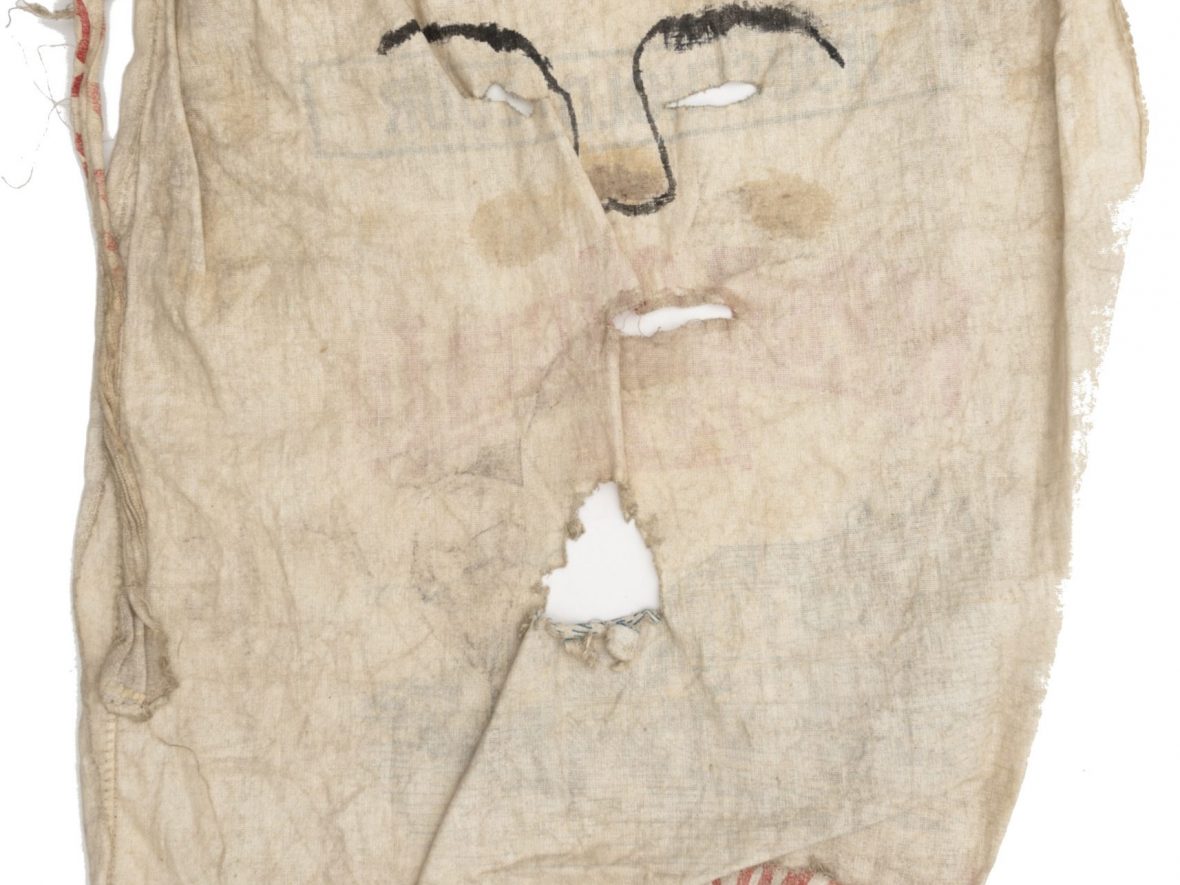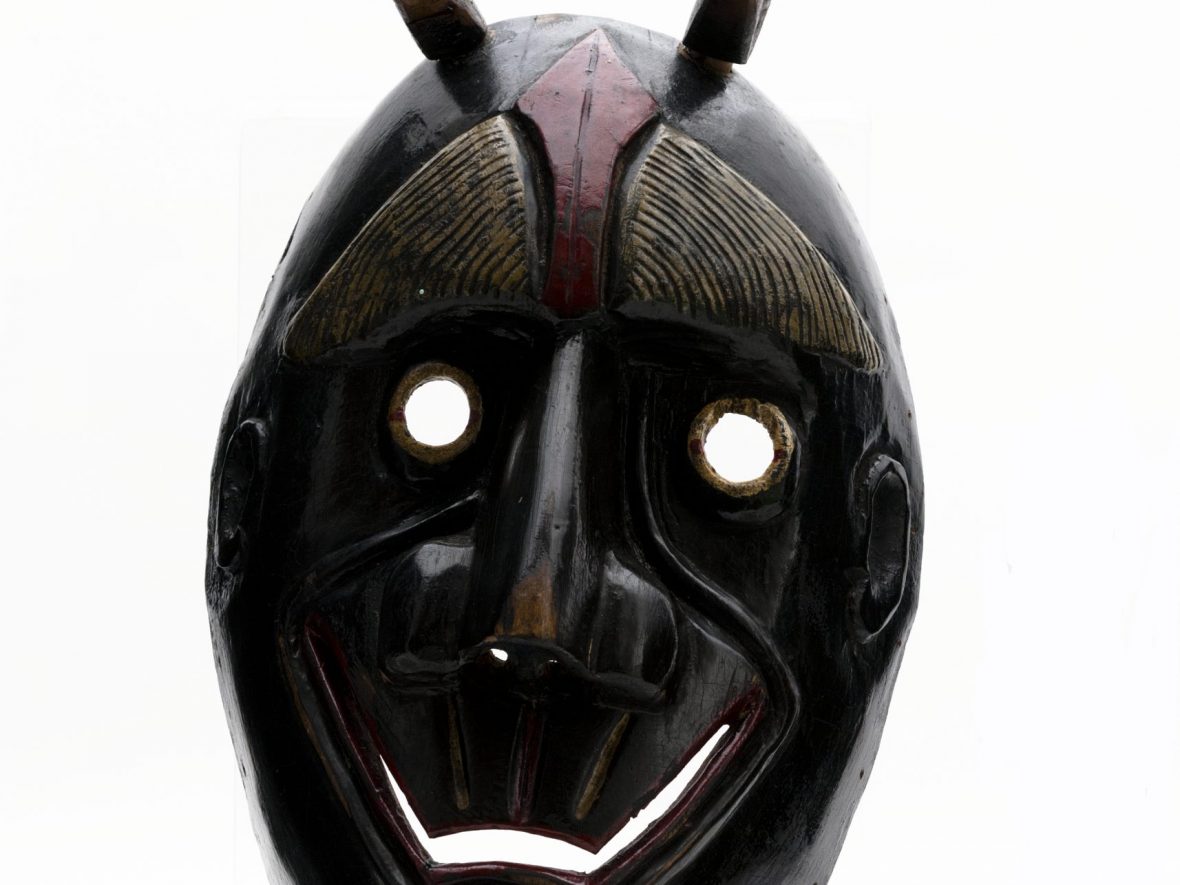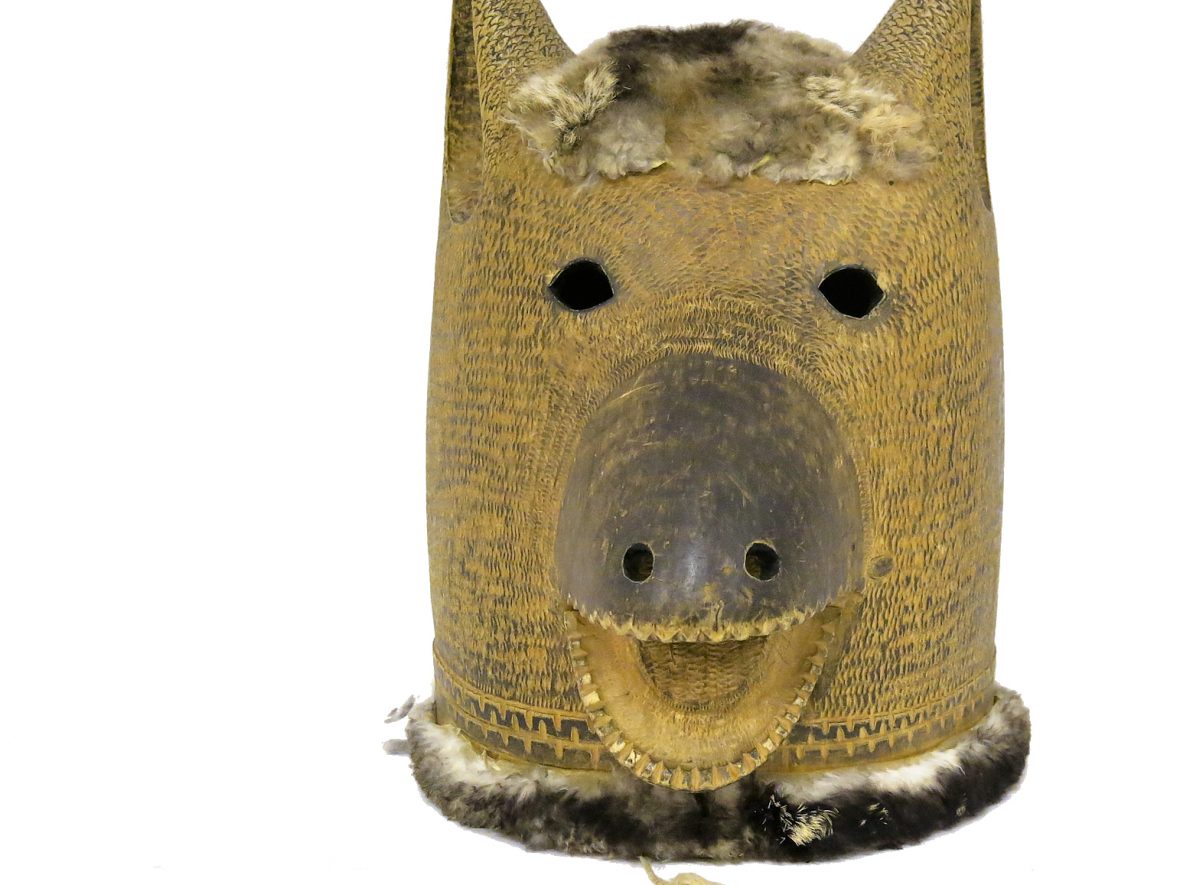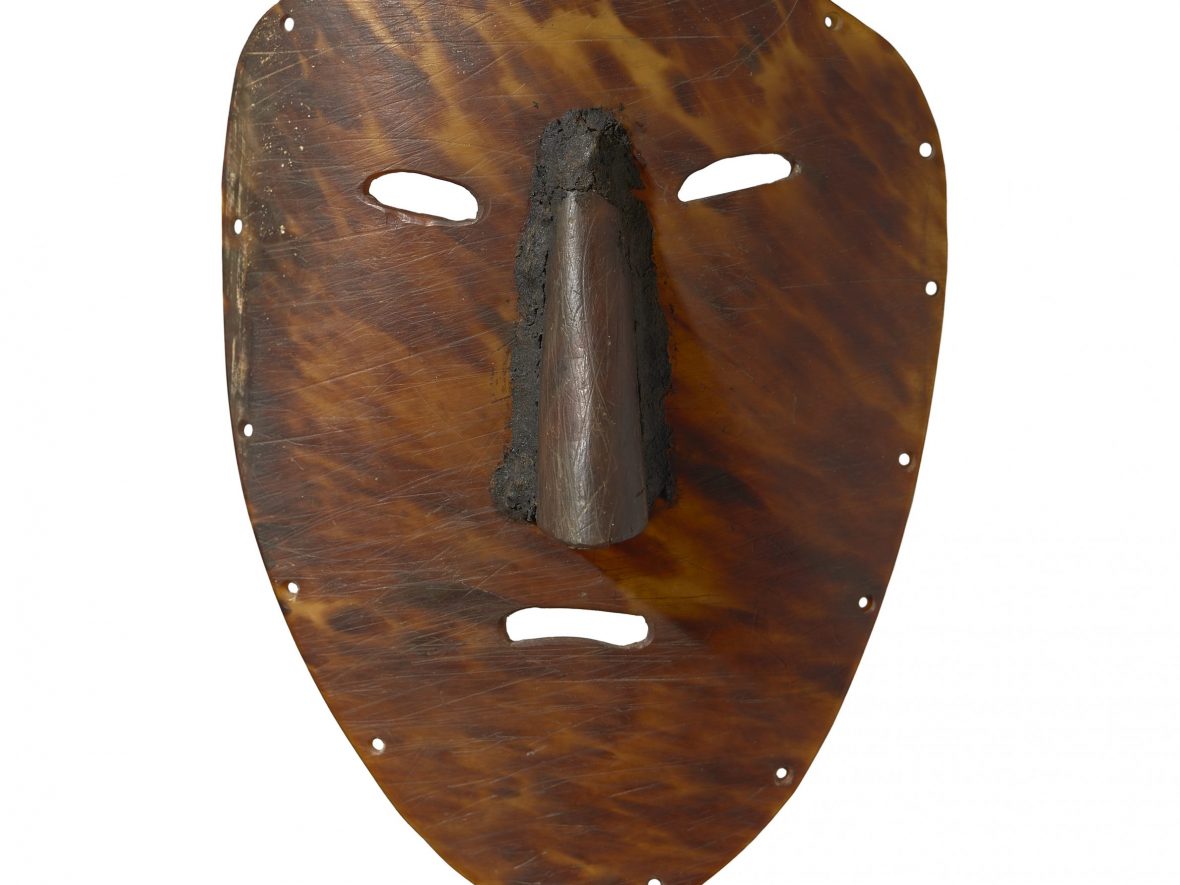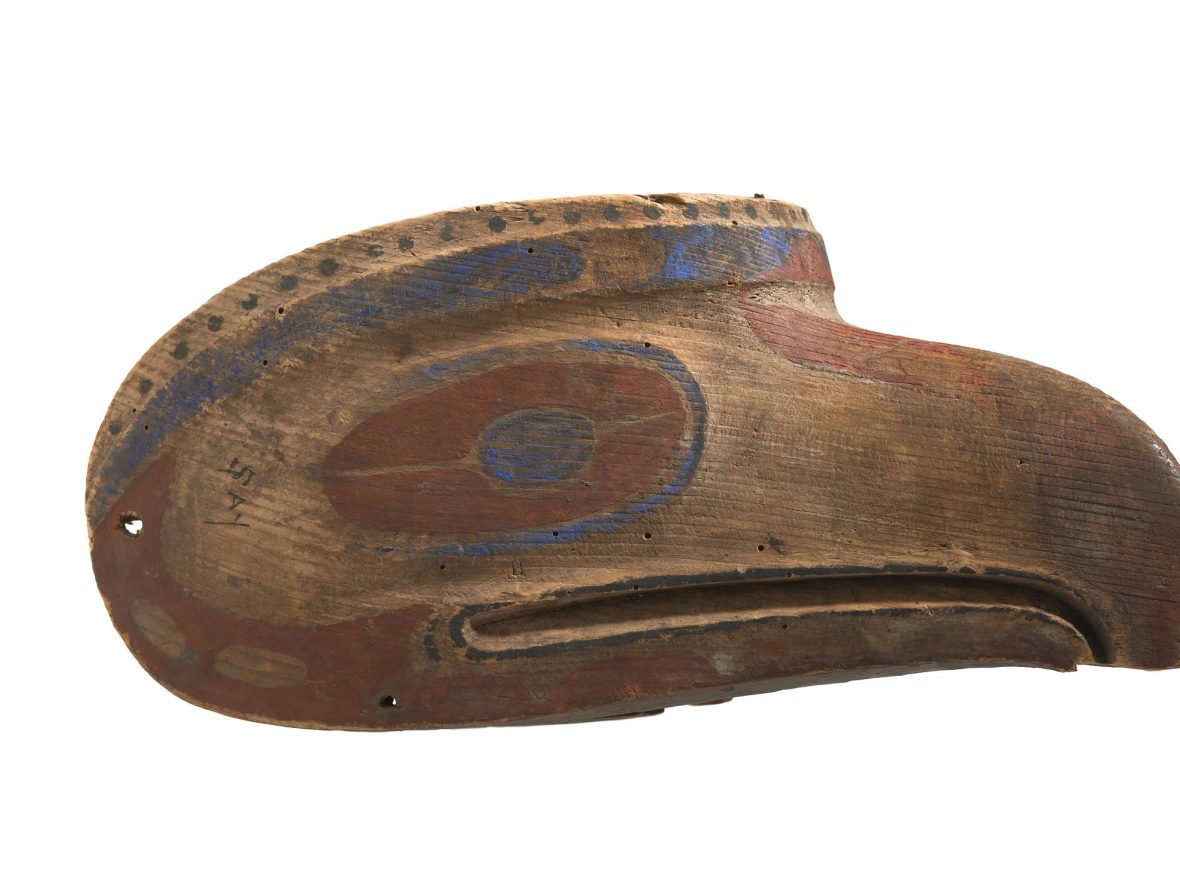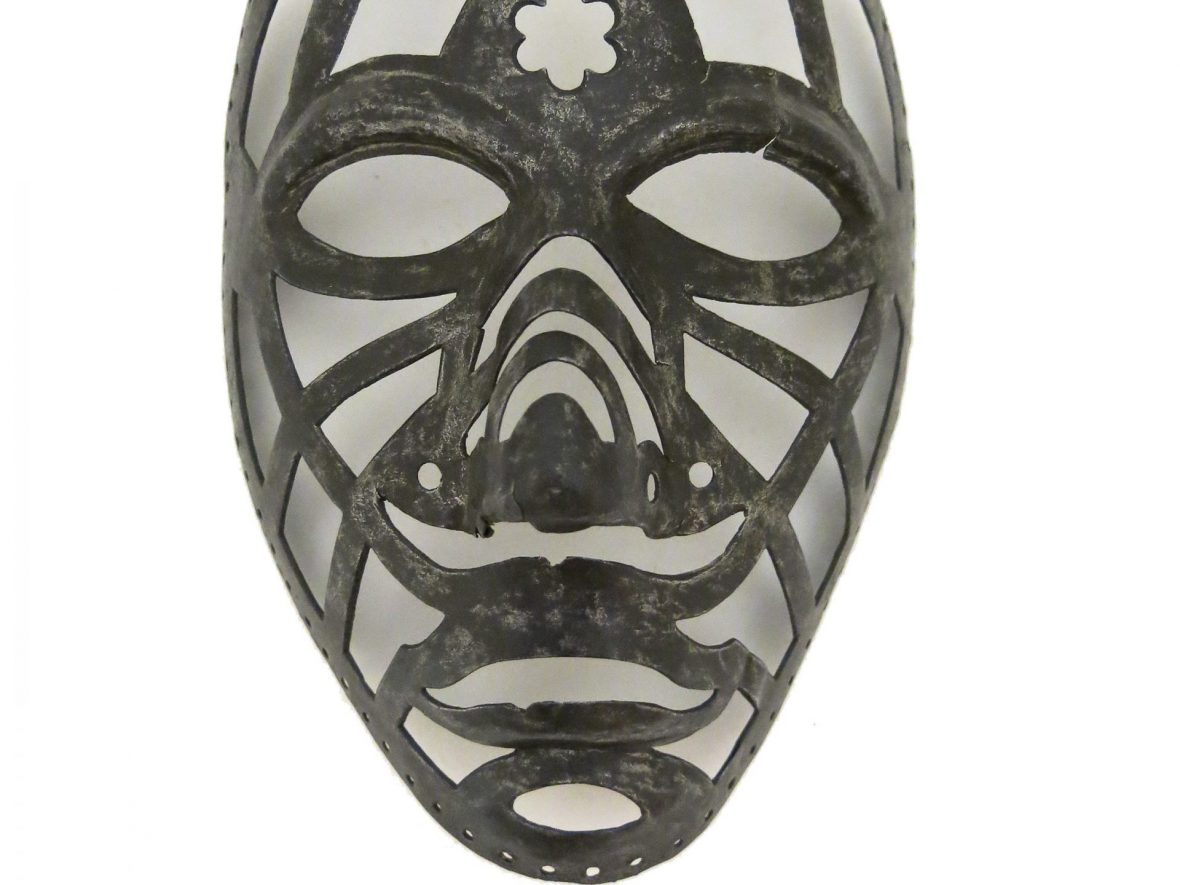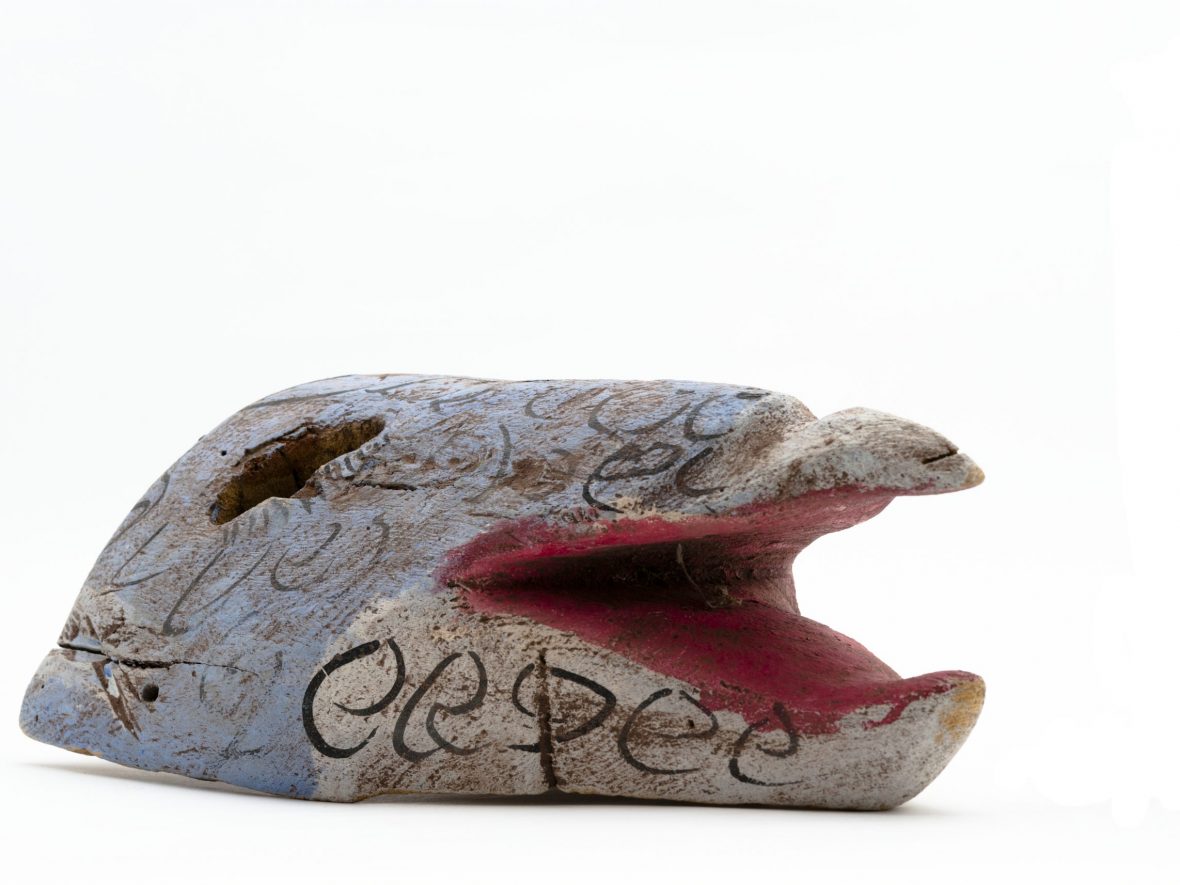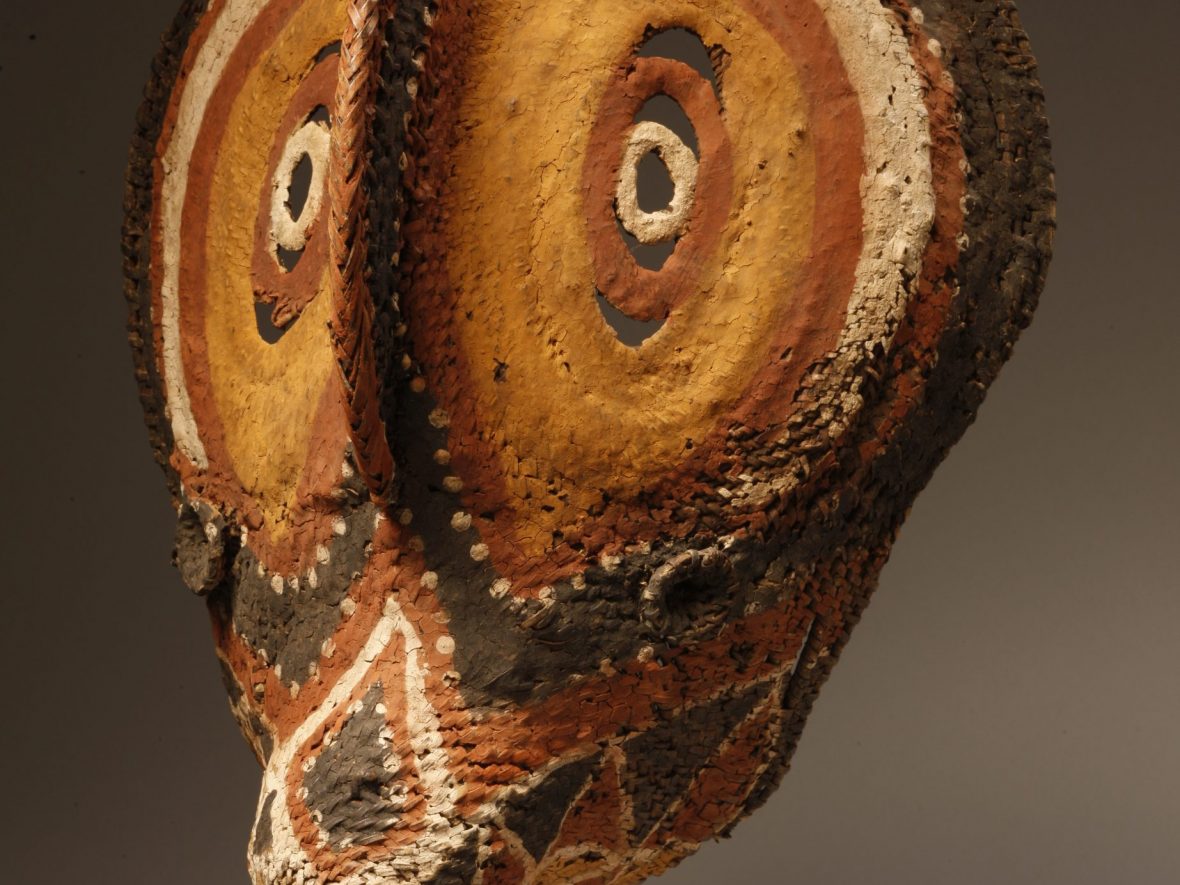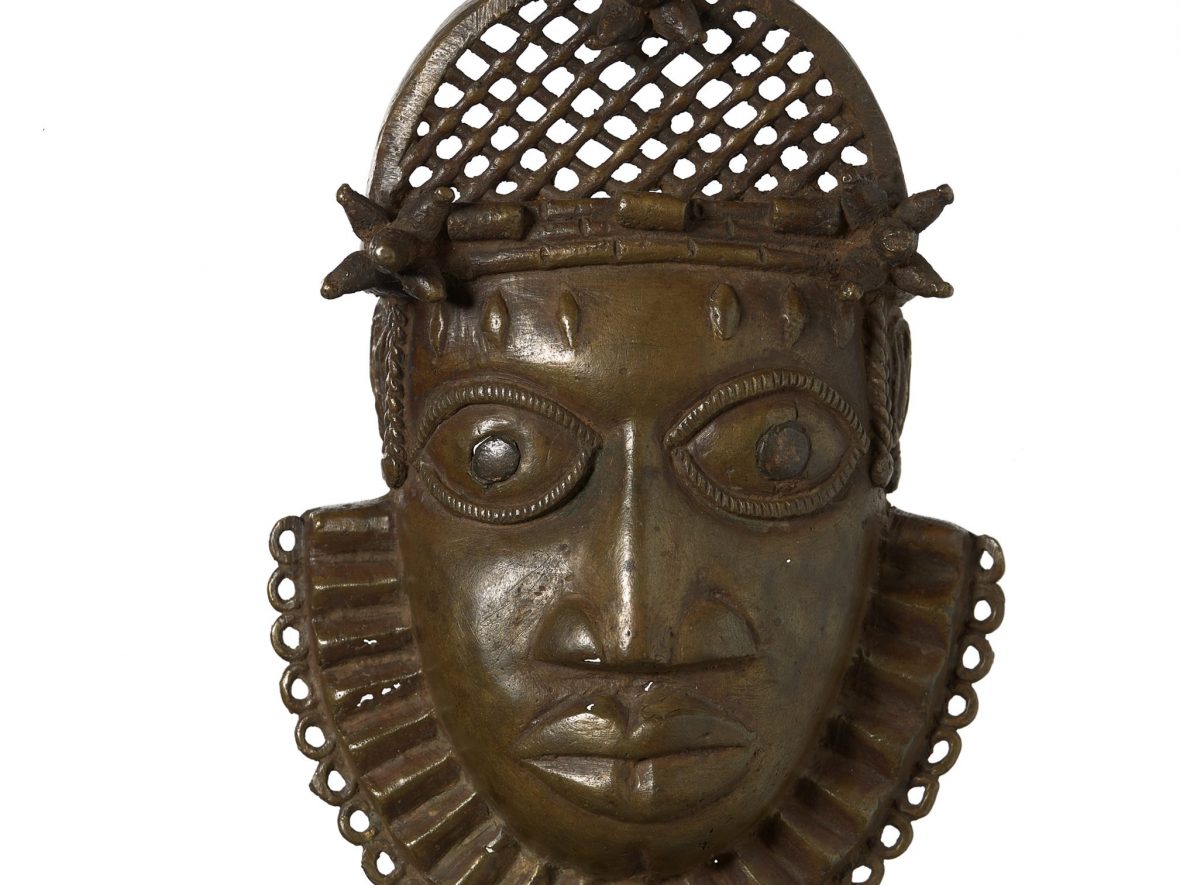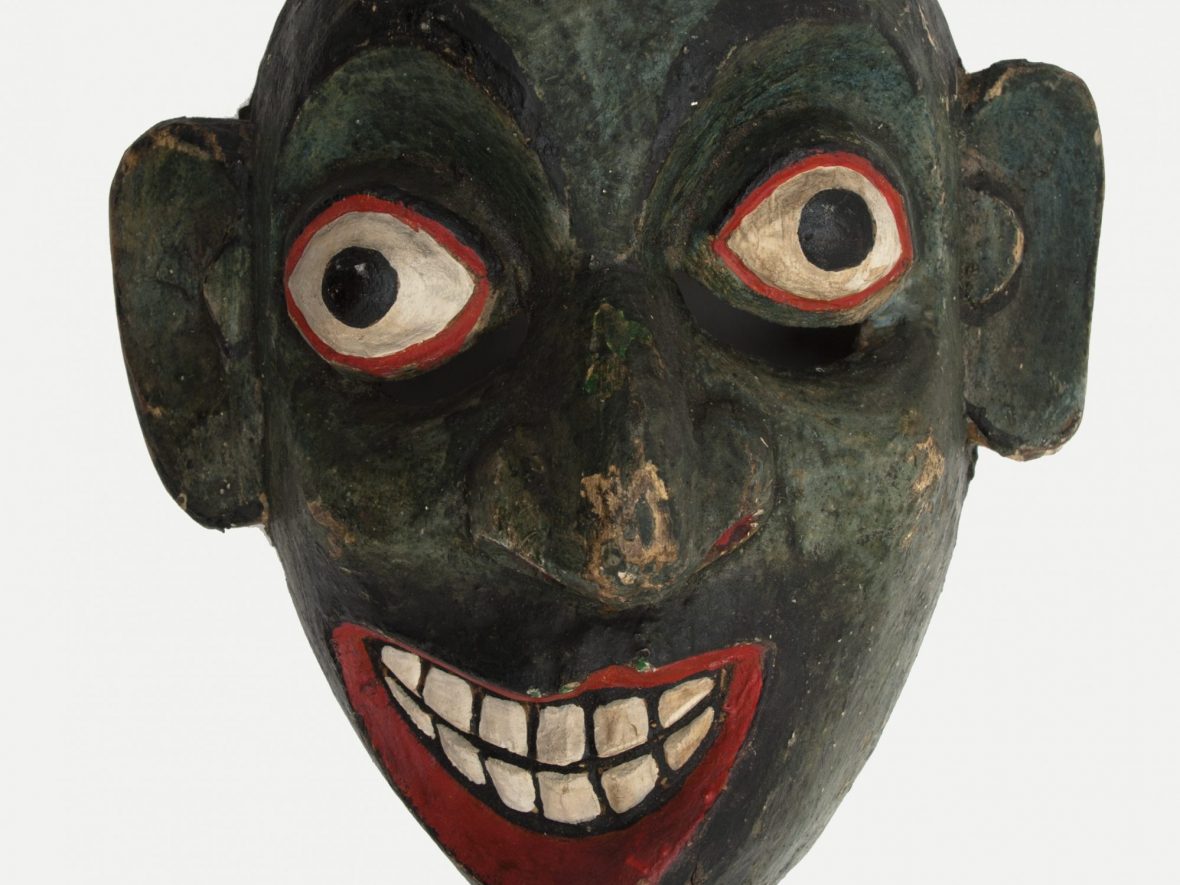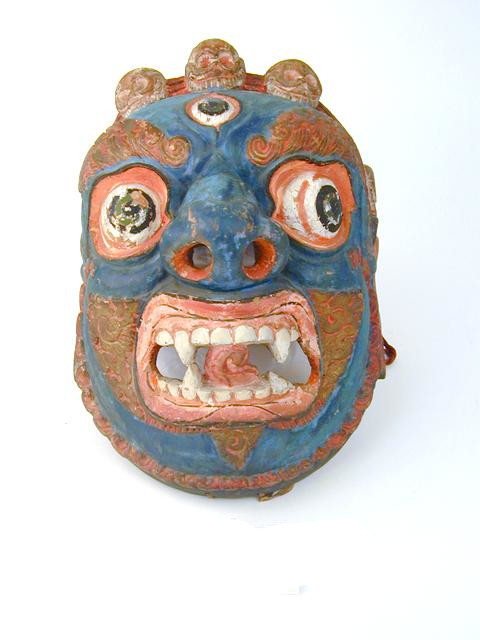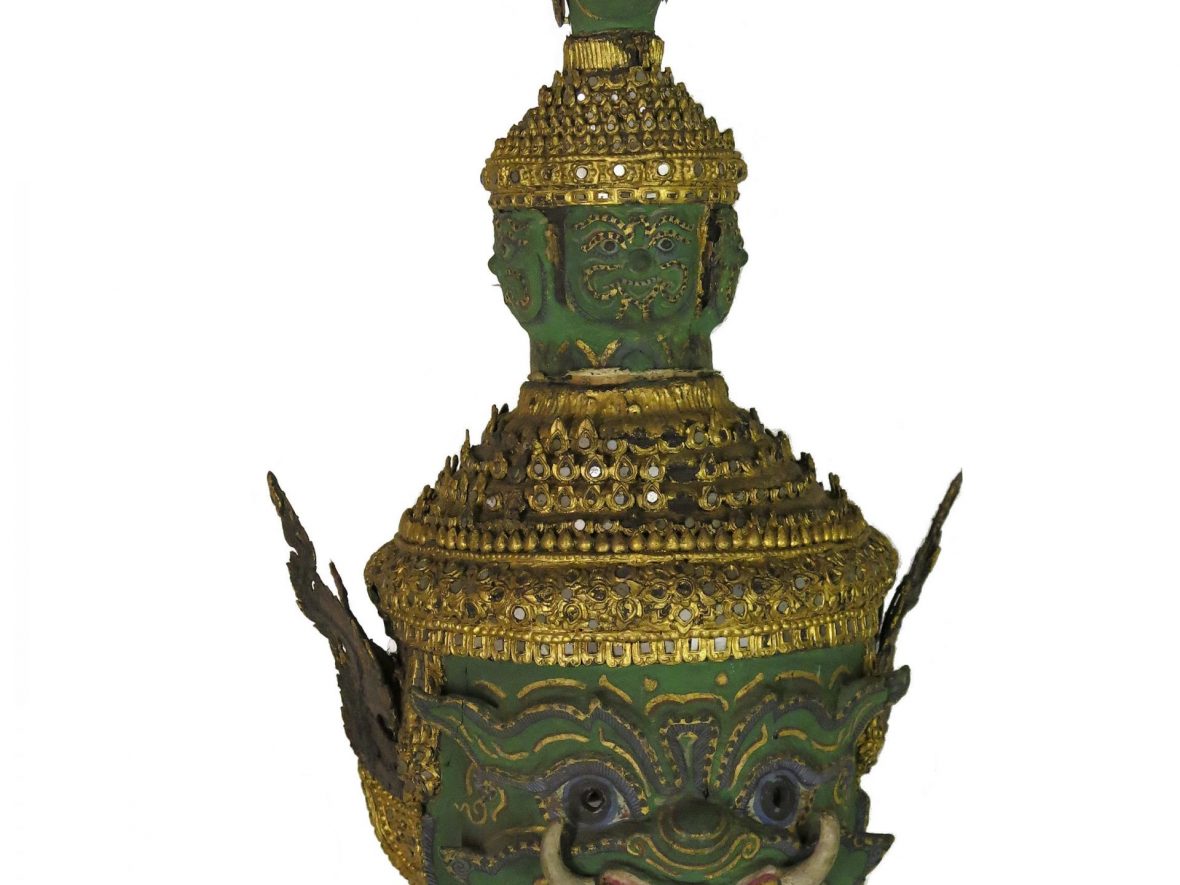Masks
Explore some of the many masks at the Horniman - download the resources below.
Download the resources below, or if you would like to make your own trails or worksheets tailored to your visit, many of the images and text below (and in our other resources) can be easily copied and pasted to your own design.
- Perhaps use images from objects located in different galleries and in the Gardens to create a challenge or simple trail through the Museum to find specific objects or places.
- Use object images to encourage independent research, for instance, find out and write down three facts about an object or group of objects. Alternatively, give facts or clues and challenge your pupils to identify mystery objects.
- Set an alphabetical challenge ie find or draw 26 objects one for each letter of the alphabet.
- Create a sketchbook challenge.
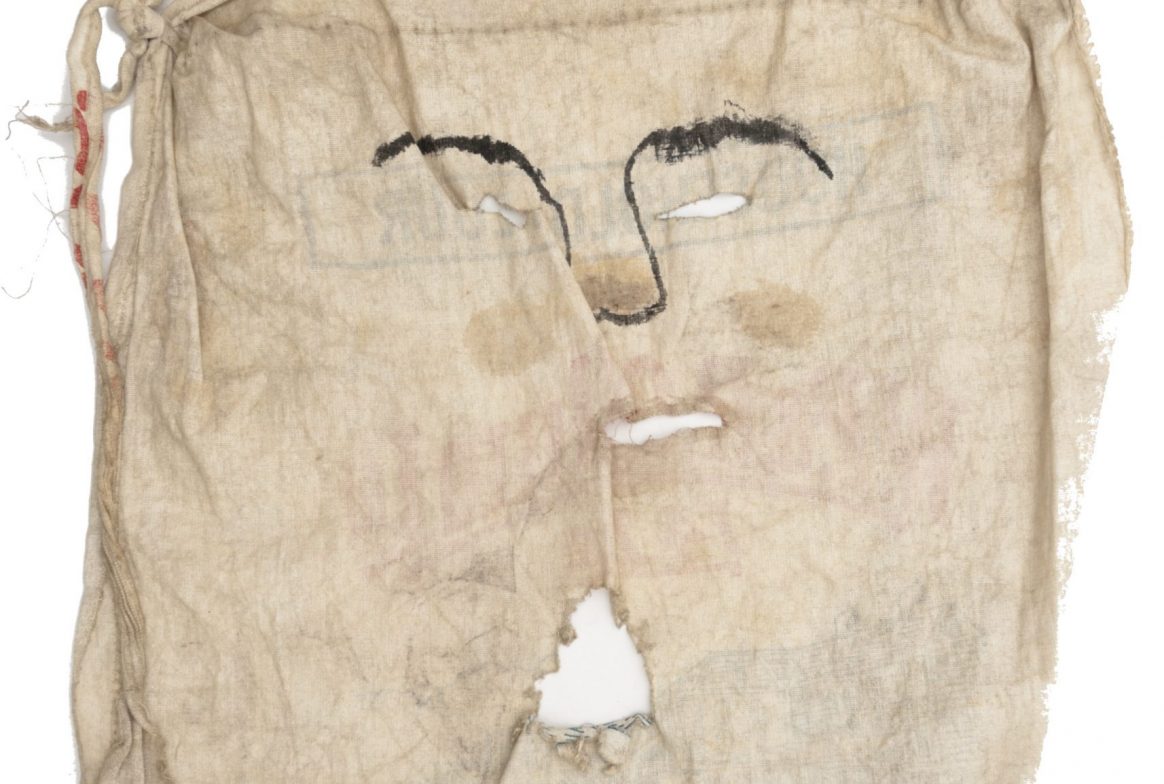
Celtic Halloween mask
This Halloween mask is made from a square piece of cloth from a flour bag.
Although Halloween is widely celebrated on 31st October around the world, it is believed that in Ireland it has its roots in Samhain (old Irish for ‘summer’s end’), a Celtic celebration of the transition between summer and winter.
At the end of the harvest season, Samhain was celebrated over three days with food and drink and acknowledging otherworldly beings. It was believed that this was a time when the spirits (Aos Sí) entered the human world and circulated among the living, who both feared and respected them. Offerings were left out, candles were lit and table places were set for these visitors.
The practice of dressing in disguise and visiting neighbours started in the 16th century. How does this mask compare with a Halloween costume you have worn?
Although Halloween is widely celebrated on 31st October around the world, it is believed that in Ireland it has its roots in Samhain (old Irish for ‘summer’s end’), a Celtic celebration of the transition between summer and winter.
At the end of the harvest season, Samhain was celebrated over three days with food and drink and acknowledging otherworldly beings. It was believed that this was a time when the spirits (Aos Sí) entered the human world and circulated among the living, who both feared and respected them. Offerings were left out, candles were lit and table places were set for these visitors.
The practice of dressing in disguise and visiting neighbours started in the 16th century. How does this mask compare with a Halloween costume you have worn?
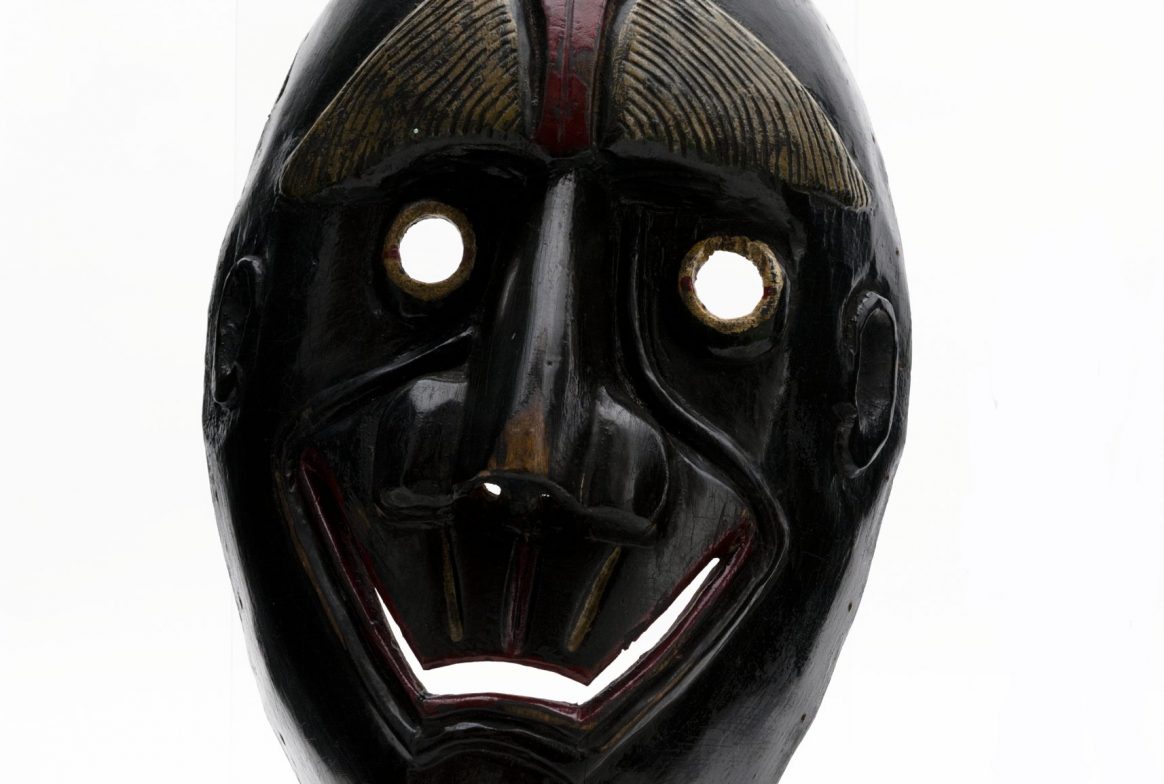
Winter demon mask
This painted wooden mask appears to represent a demon.
There is a rich folk history in Switzerland of producing masks for such festivals and ceremonies, which mark the coming of the long Alpine winter.
Because Switzerland borders many different European countries, the masks vary in style across different regions. This mask was produced in Sarganserland, in eastern Switzerland, where some of the earliest wooden masks were produced at the turn of the 19th century.
Before the 1930s the masks produced here were usually character masks of village personalities, but from the 1930s onwards, demonic masks such
There is a rich folk history in Switzerland of producing masks for such festivals and ceremonies, which mark the coming of the long Alpine winter.
Because Switzerland borders many different European countries, the masks vary in style across different regions. This mask was produced in Sarganserland, in eastern Switzerland, where some of the earliest wooden masks were produced at the turn of the 19th century.
Before the 1930s the masks produced here were usually character masks of village personalities, but from the 1930s onwards, demonic masks such
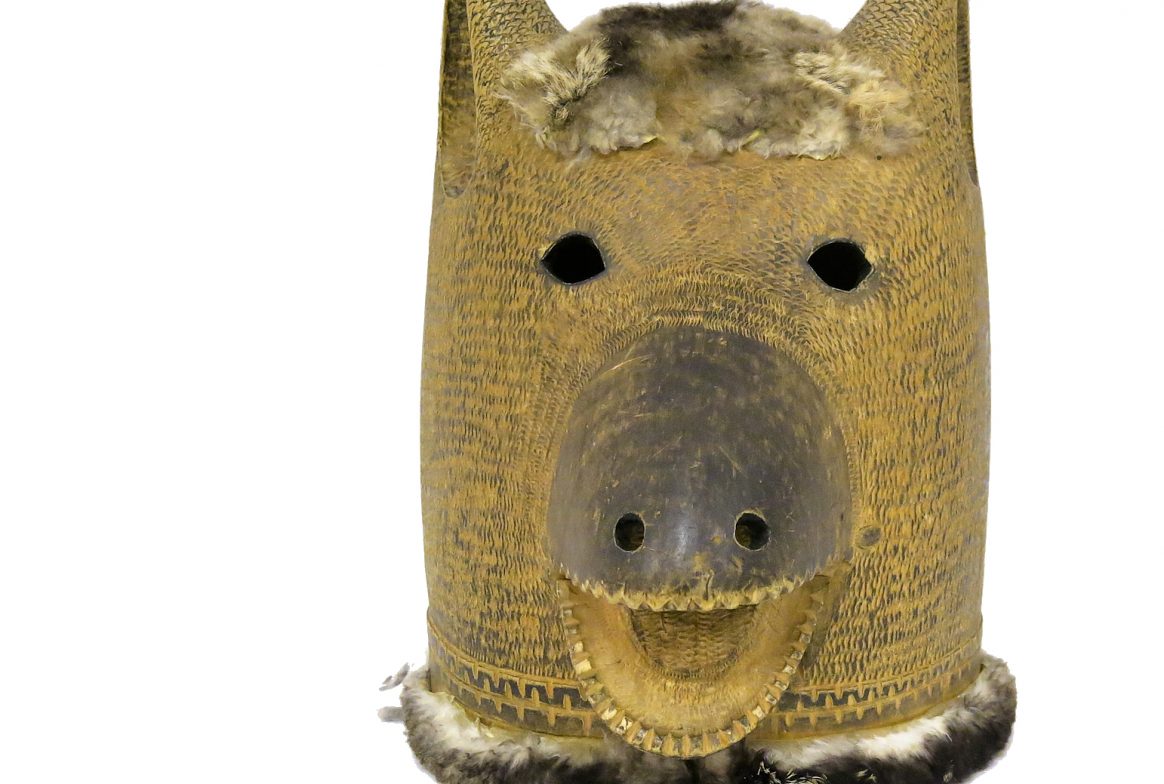
Winter festival mask
Another European winter mask, this large wooden mask is from Slovakia.
Representing a bear, its lower jaw can be opened and closed by moving a string. The top of the head and base are covered with fur, possibly from a wild cat.
This type of mask was made by people in Slovakia with the tools they had at home. It would have been used during the Slovakian ‘Fašiangy‘ festival and at Christmas. It was usually worn with a costume, often a fur coat, and a chain or a belt with bells attached to it.
Bears were a symbol of strength and, as they sleep in winter, they also represented rebirth and new life. The bear character was present at the festival mainly to protect people from demons. What other symbols of rebirth can you think of?
Representing a bear, its lower jaw can be opened and closed by moving a string. The top of the head and base are covered with fur, possibly from a wild cat.
This type of mask was made by people in Slovakia with the tools they had at home. It would have been used during the Slovakian ‘Fašiangy‘ festival and at Christmas. It was usually worn with a costume, often a fur coat, and a chain or a belt with bells attached to it.
Bears were a symbol of strength and, as they sleep in winter, they also represented rebirth and new life. The bear character was present at the festival mainly to protect people from demons. What other symbols of rebirth can you think of?
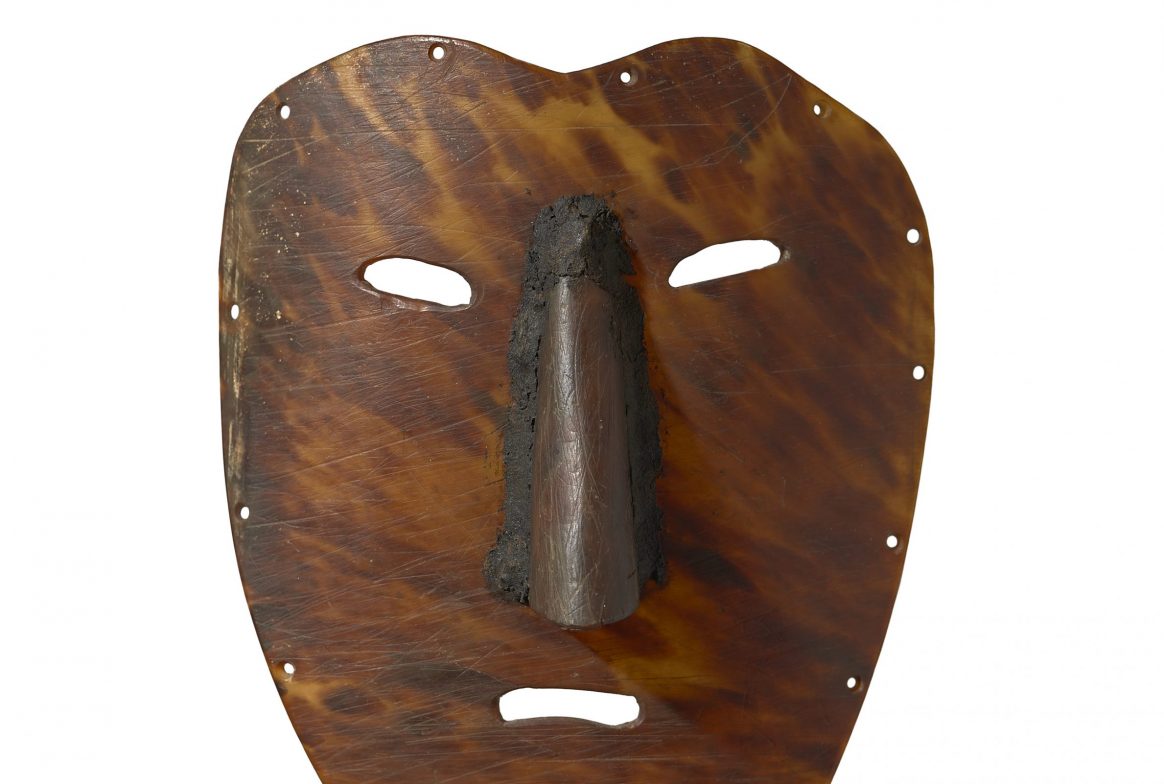
Ceremonial mask
This mask is made from turtle shell which has been boiled to soften and shape it into a human-like face. It has holes all around the edge, which would have held feathers, possibly from a cassowary bird.
Turtle shell masks such as this are characteristic of the Torres Straits Islands between the south of Papua New Guinea and the north of Australia, where the islanders hunt for fish, turtle and the marine mammal, dugong.
The masks show many different animals such as birds, fish and reptiles or humans, representing local mythical heroes. The wearer would be dressed in a grass costume for initiation and funeral ceremonies or ‘increase rituals’ - rituals to increase the number of fish and animal species available to hunt.
Can you picture what the mask would have looked like with its fringe of feathers?
Turtle shell masks such as this are characteristic of the Torres Straits Islands between the south of Papua New Guinea and the north of Australia, where the islanders hunt for fish, turtle and the marine mammal, dugong.
The masks show many different animals such as birds, fish and reptiles or humans, representing local mythical heroes. The wearer would be dressed in a grass costume for initiation and funeral ceremonies or ‘increase rituals’ - rituals to increase the number of fish and animal species available to hunt.
Can you picture what the mask would have looked like with its fringe of feathers?
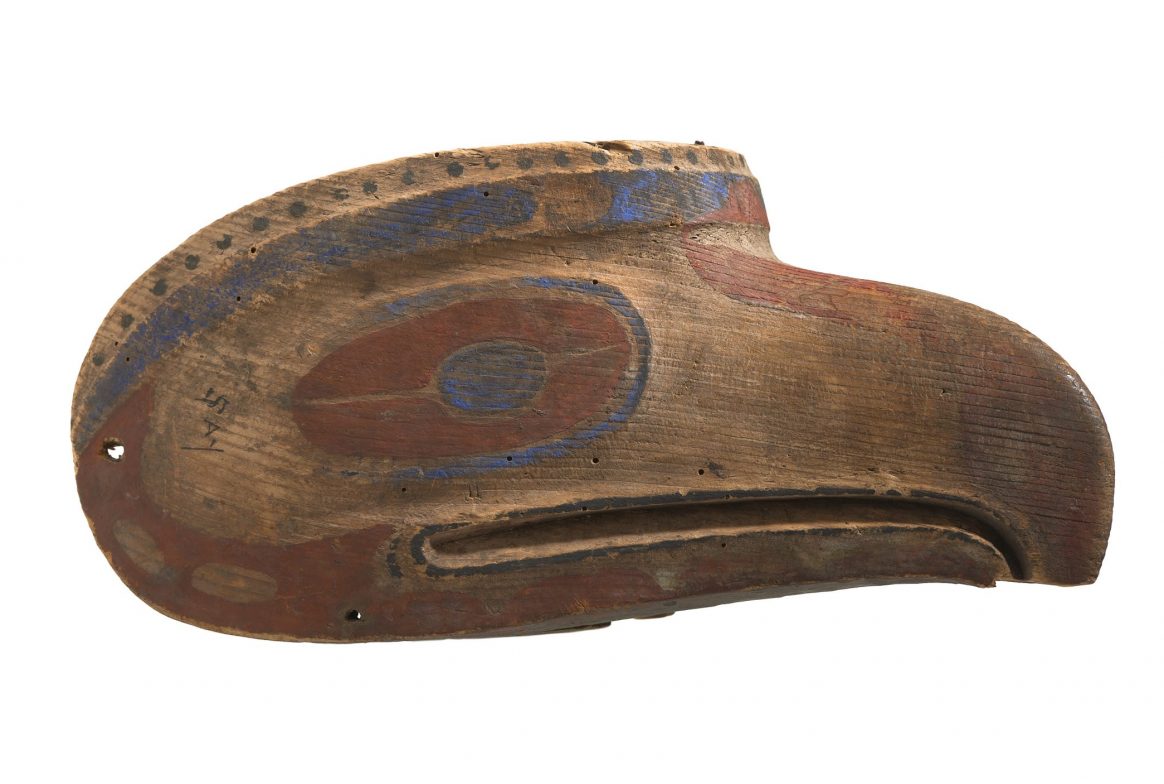
Ceremonial mask
This hawk mask is from a community of the Northwest Coast of North America, probably the Nuu-chah-nulth, who live on the West Coast of Vancouver Island in Canada.
The hawk is a symbol of noble families and represents mythical ancestors, and features in many ceremonies and stories.
Masks such as this are worn during dances at potlatches (celebrations including feasts, dances, religious rituals, money exchanges, fighting demonstrations, trade deals, marriages, births, deaths and chiefdom ceremonies).
The masks are also used to perform stories about the histories of the families and clans on the coast. The masks were believed to bring the ancestral beings to life. Which animal would you choose to represent your family?
The hawk is a symbol of noble families and represents mythical ancestors, and features in many ceremonies and stories.
Masks such as this are worn during dances at potlatches (celebrations including feasts, dances, religious rituals, money exchanges, fighting demonstrations, trade deals, marriages, births, deaths and chiefdom ceremonies).
The masks are also used to perform stories about the histories of the families and clans on the coast. The masks were believed to bring the ancestral beings to life. Which animal would you choose to represent your family?

Mystery mask
This mask came from the former collection of the late William Randolph Hearst, Esq., removed from St. Donat’s Castle in South Wales. Hearst was a very famous American businessman, politician and newspaper publisher.
The purpose of this mask is something of a mystery. It is an Italian mask dating from the 16th-17th century and is made from iron, with punched holes around the whole edge and traces of gold paint on the back.
It was acquired by the Horniman Museum in 1953 from Sotheby’s auction house, which described it as ‘A rare Executioner’s Mask’, possibly to make it attractive to potential buyers; however it is more likely to be a face guard to protect a horse rider when riding through wooded country.
Which description do you think is more believable? Can you spot features on the mask that make it suitable for that use?
The purpose of this mask is something of a mystery. It is an Italian mask dating from the 16th-17th century and is made from iron, with punched holes around the whole edge and traces of gold paint on the back.
It was acquired by the Horniman Museum in 1953 from Sotheby’s auction house, which described it as ‘A rare Executioner’s Mask’, possibly to make it attractive to potential buyers; however it is more likely to be a face guard to protect a horse rider when riding through wooded country.
Which description do you think is more believable? Can you spot features on the mask that make it suitable for that use?

Dance mask
This half-mask is made from carved wood, with moustache and eyebrows made from animal skin and hair.
The mask was used in performances of Balinese Topeng, a form of dance accompanied by gamelan (a traditional ensemble of percussion instruments in Java and Bali), in which masked, costumed performers act out traditional tales of myths, kings and heroes.
This mask represents Bondres Cungih, a clown figure born with a cleft lip and palate. This trickster enjoys making puns and making a nuisance to authority figures. He is often shown as a lazy character, who avoids doing the community service that all villagers have to do. He knows many songs but struggles to sing them due to his speech impediment.
How does this clown-like figure compare with other clowns you may have come across?
This mask represents Bondres Cungih, a clown figure born with a cleft lip and palate. This trickster enjoys making puns and making a nuisance to authority figures. He is often shown as a lazy character, who avoids doing the community service that all villagers have to do. He knows many songs but struggles to sing them due to his speech impediment.
How does this clown-like figure compare with other clowns you may have come across?
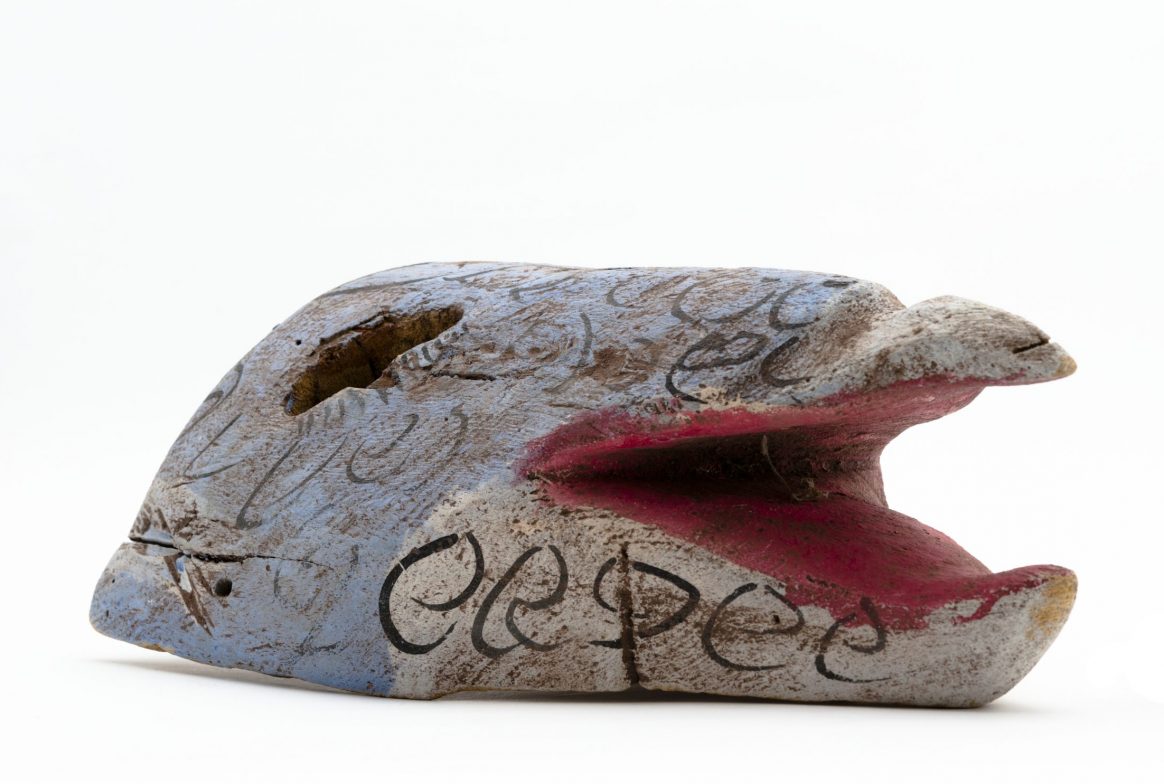
Dance mask
This carved wooden mask in the shape of a bird is from the Mexican state of Guerrero, which is known for producing a wide range of masks for many local festivals, mostly on saints’ feast days and public holidays. Many of the masks are animal-based and are used for dances, including the famous Tigre (Jaguar).
The mask shown here probably dates from the middle of the 20th century and is thought to have belonged to the masked festivals of the Tlapaneco people, where men perform the Danza de los Zopilotes (the dance of the Turkey Vultures) with masks that have long beaks such as this one.
What makes this mask bird-like even though it is so simple in its design?
The mask shown here probably dates from the middle of the 20th century and is thought to have belonged to the masked festivals of the Tlapaneco people, where men perform the Danza de los Zopilotes (the dance of the Turkey Vultures) with masks that have long beaks such as this one.
What makes this mask bird-like even though it is so simple in its design?
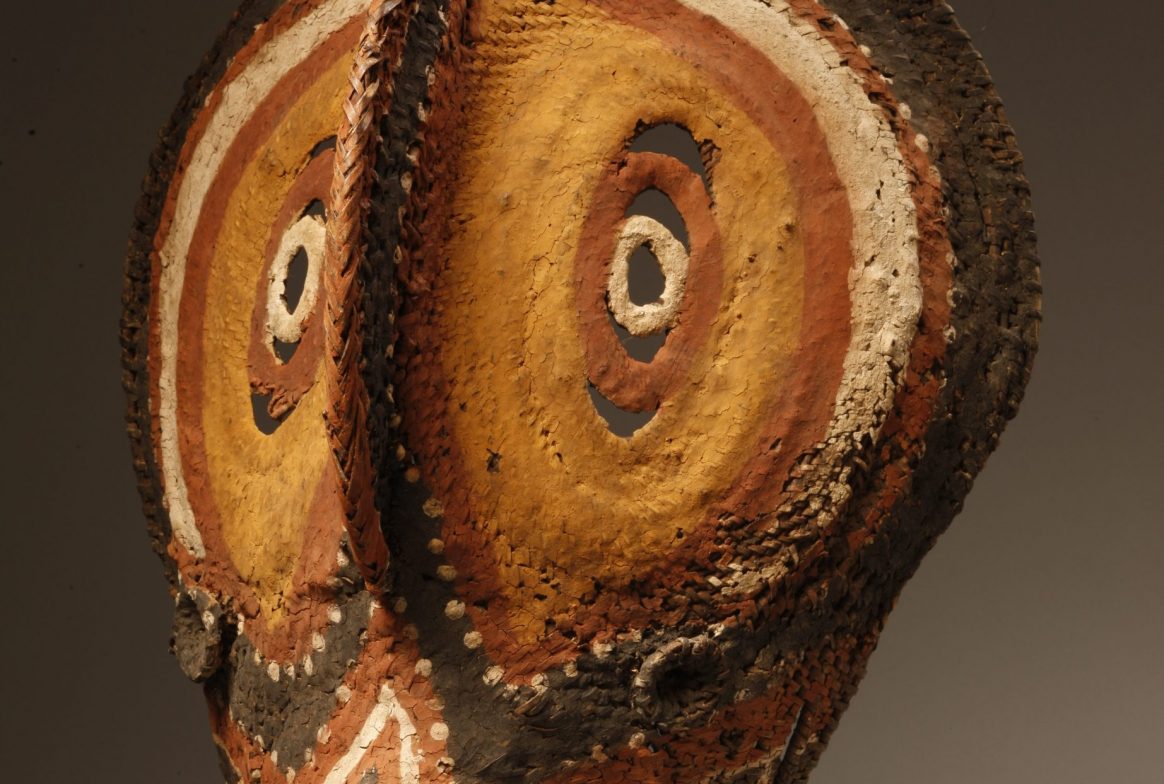
Yam mask
This mask was never worn by a person. It is an Abelam yam mask (baba-tagwa) made from coiled basketry covered with gum and painted.
The Abelam people in the Sepik region of Papua New Guinea grow two types of yams (a root vegetable) – smaller ones to eat and larger ones for ceremonies.
Each initiated man in the village has a trading partner from another village, and they compete to grow the largest yam. The yams are tended carefully and sometimes carried like babies. In Abelam language, ‘to plant a yam’ also means ‘to bury a dead person’.
For the presentation ceremony, the yams are decorated with specially made masks named after ancestors and displayed in front of the meeting house of the host village. The men exchange yams and the one with the largest yam is considered the better man.
How would you describe the mask’s expression?
The Abelam people in the Sepik region of Papua New Guinea grow two types of yams (a root vegetable) – smaller ones to eat and larger ones for ceremonies.
Each initiated man in the village has a trading partner from another village, and they compete to grow the largest yam. The yams are tended carefully and sometimes carried like babies. In Abelam language, ‘to plant a yam’ also means ‘to bury a dead person’.
For the presentation ceremony, the yams are decorated with specially made masks named after ancestors and displayed in front of the meeting house of the host village. The men exchange yams and the one with the largest yam is considered the better man.
How would you describe the mask’s expression?
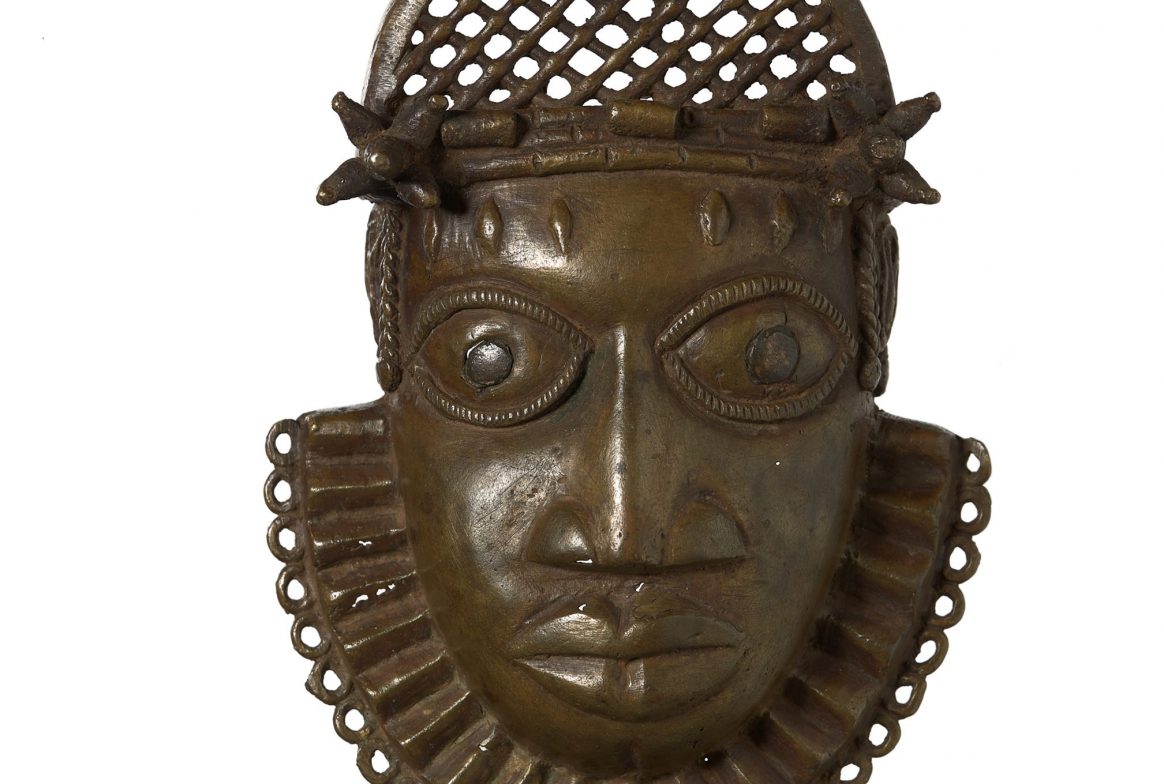
Hip mask
Like the previous mask, this is another unusual mask that is not worn on the face. This is a pendant that is worn on the left hip.
It was created for the court of the Kingdom of Benin, a state that arose in southwestern Nigeria in the 13th to 14th century and was ruled by an Oba (divine king). Chiefs and officials in ancient Benin wore mask pendants as ornaments, and sometimes still do today at ceremonies.
The mask is made of copper alloy and wood and shows a face with a collar and a coral bead headdress, typically worn by the Oba.
Such pendants often feature a collar of mudfish. Although in this example the collar does not resemble fish, it could be a heavily stylised design. As mudfish can live both on land and in water, they symbolise the Oba’s dual nature as a human and divine entity.
It was created for the court of the Kingdom of Benin, a state that arose in southwestern Nigeria in the 13th to 14th century and was ruled by an Oba (divine king). Chiefs and officials in ancient Benin wore mask pendants as ornaments, and sometimes still do today at ceremonies.
The mask is made of copper alloy and wood and shows a face with a collar and a coral bead headdress, typically worn by the Oba.
Such pendants often feature a collar of mudfish. Although in this example the collar does not resemble fish, it could be a heavily stylised design. As mudfish can live both on land and in water, they symbolise the Oba’s dual nature as a human and divine entity.
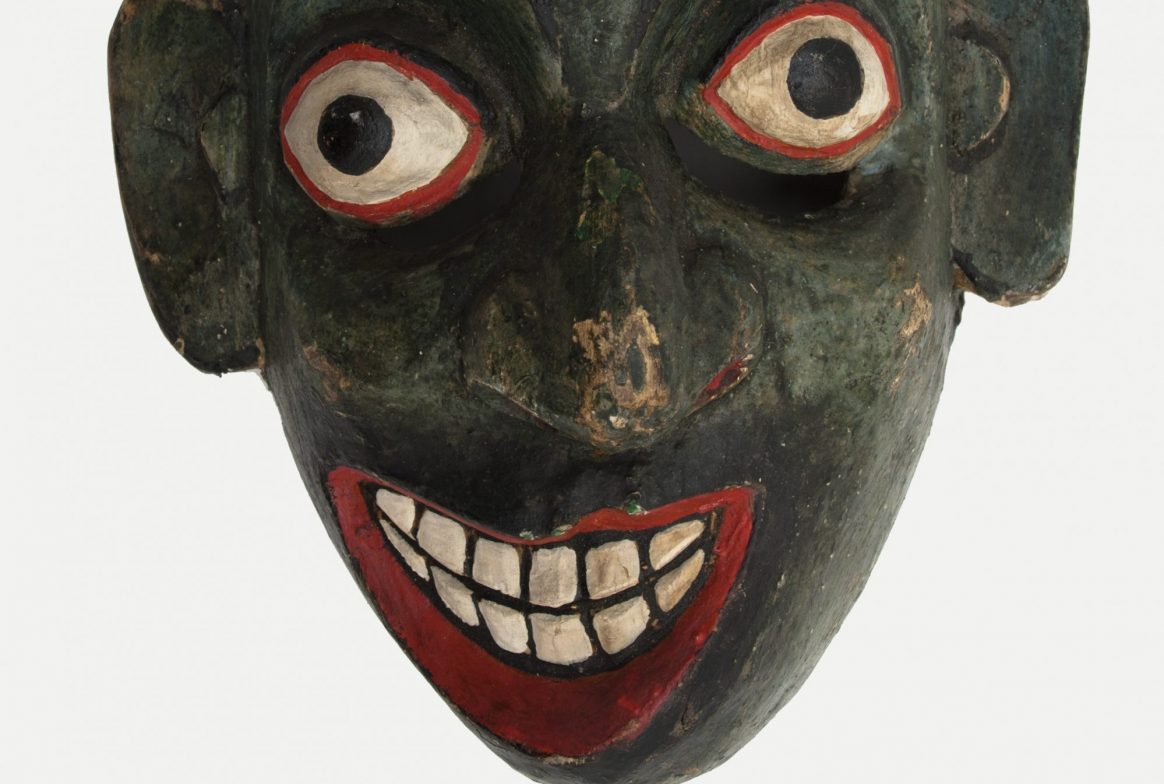
Sickness mask
This painted wooden mask is an example of a Sanni (sickness) mask traditionally used in Sri Lankan Kolam (theatre) and Tovil (exorcisms).
Sanni masks represent an ancient way to group diseases, with up to 18 different masks showing different illnesses. If ordinary medicine does not cure a person, it was believed to have been caused by one of the Sanni Yakku (sickness demons), in which case an exorcism ritual to get rid of the demon was needed, with the exorcist wearing the correct sickness mask.
The mask shown here represents Kora Sanniya, demon of paralysis and lameness, who is always shown with a mouth on one side, suggesting a stroke.
Can you design a sickness mask to represent an illness that has affected you or someone you know?
Sanni masks represent an ancient way to group diseases, with up to 18 different masks showing different illnesses. If ordinary medicine does not cure a person, it was believed to have been caused by one of the Sanni Yakku (sickness demons), in which case an exorcism ritual to get rid of the demon was needed, with the exorcist wearing the correct sickness mask.
The mask shown here represents Kora Sanniya, demon of paralysis and lameness, who is always shown with a mouth on one side, suggesting a stroke.
Can you design a sickness mask to represent an illness that has affected you or someone you know?
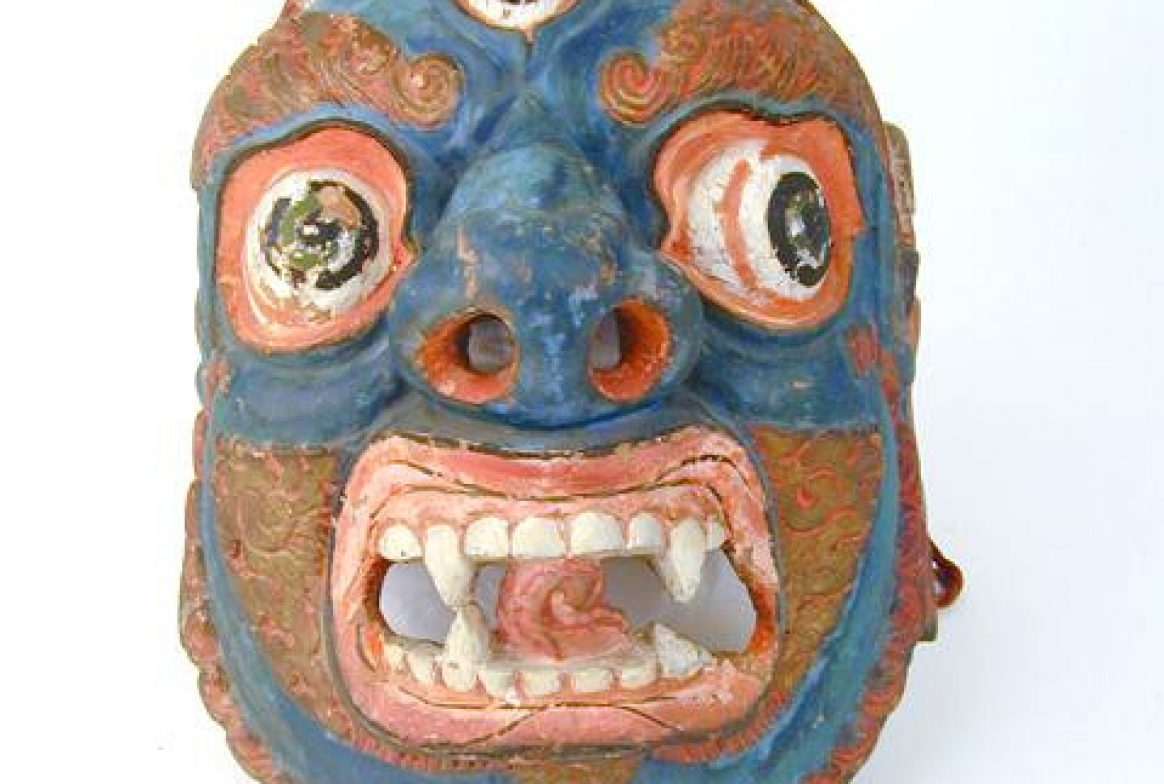
Cham dance mask
This mask is used as part of the Cham dance which is performed in specially cleansed and blessed areas in front of Buddhist temples in Tibet and India, to drive away evil forces.
It represents Mahakala, chief protector of the Buddhist faith. In Sanskrit, maha means great and kala means black or dark, so Mahakala can mean Great Dark One. His job is to chase away the enemies of Tibetan Buddhism and bring balance between good and evil.
The five skulls on top of the mask represent the five things that stop people from leading a good and sin-free life: Passion, Aggression, Ignorance, Pride and Jealousy. You can also see the third eye on this mask, which shows that it is a supernatural being.
What can you see in this face that makes this mask look both good and evil?
It represents Mahakala, chief protector of the Buddhist faith. In Sanskrit, maha means great and kala means black or dark, so Mahakala can mean Great Dark One. His job is to chase away the enemies of Tibetan Buddhism and bring balance between good and evil.
The five skulls on top of the mask represent the five things that stop people from leading a good and sin-free life: Passion, Aggression, Ignorance, Pride and Jealousy. You can also see the third eye on this mask, which shows that it is a supernatural being.
What can you see in this face that makes this mask look both good and evil?

Khon dance mask
This painted papier-mâché mask would have been used in Khon performances, sacred masked dances that were held for the royal court in Thailand.
It represents the character Thotsakan, a green, ten-headed demon from the Ramakien story. This epic story was composed in the 18th century by the Thai king and is loosely based on the Indian story Ramayana. In it, the wicked demon Thotsakan captures Nang Sida, who is rescued by the lead character Phra Ram and the monkey hero Hanuman. All Thai kings since 1782 have been associated with the heroic figure of Phra Ram. The Khon masked dances teach people lessons about ethics, living in harmony with nature, sibling loyalty and love. Where are all ten of the demon’s heads on the mask?
It represents the character Thotsakan, a green, ten-headed demon from the Ramakien story. This epic story was composed in the 18th century by the Thai king and is loosely based on the Indian story Ramayana. In it, the wicked demon Thotsakan captures Nang Sida, who is rescued by the lead character Phra Ram and the monkey hero Hanuman. All Thai kings since 1782 have been associated with the heroic figure of Phra Ram. The Khon masked dances teach people lessons about ethics, living in harmony with nature, sibling loyalty and love. Where are all ten of the demon’s heads on the mask?
